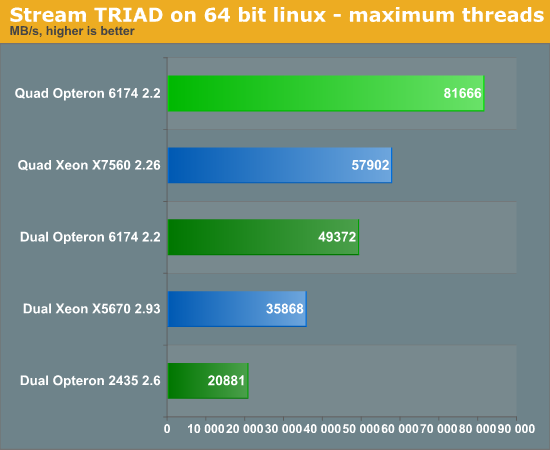Server Clash: DELL's Quad Opteron DELL R815 vs HP's DL380 G7 and SGI's Altix UV10
by Johan De Gelas on September 9, 2010 7:30 AM EST- Posted in
- IT Computing
- AMD
- Intel
- Xeon
- Opteron
Bandwidth is an important factor for quite a few HPC and virtualization workloads. So although Stream is a synthetic benchmark, we feel it is interesting to include Stream. If gives a rough idea which system will shine in multi-thread bandwidth limited applications.

Four CPUs with each four DDR-3 channels at 1333 MHz, combined with an excellent (2 x 6.4 GT/s + 2 x 3.2 GT/s) HT-3 CPU interconnect links gives the highest Stream score we have encountered so far. The maximum theoretical bandwidth is limited by the 1.8 GHz speed of each 64 bit memory controller: 8 bytes x 1.8 GHz, or 28.8 GB/s. Four memory controller should thus achieve about 115 GB/s/. So we get about 71% of the theoretical bandwidth with a decently but not extremely optimized binary. AMD tested with such a “benchmark” binary and achieved 110 GB/s.
The result is that AMD’s 12-core scores extremely well in typically bandwidth hungry HPC applications such as Ansys Fluent and LS-Dyna. Although the HPC server market is relatively small (about 5% ), it is an important one for AMD. AMD has been dominating this market since the introduction of the Opteron back in 2003. The low clockspeeds and delayed introduction of the AMD “Barcelona” in 2007 caused a lot of trouble in most server markets, but Barcelona was in a lot of HPC applications still the fastest compared to Intel’s Xeon 5400. AMD’s did not lose significant marketshare in this niche market until the introduction of the Xeon 5500 “Nehalem”. The Magny-cours Opteron has put an end to that period.










51 Comments
View All Comments
Chrisrodinis - Thursday, February 27, 2014 - link
This article is about Dell servers in 2010. For comparison purposes here is an overview of a Dell PowerEdge M420 Blade server. This video has cool effects with upbeat production values. Please check it out, thanks: https://www.youtube.com/watch?v=iKIG430z0PI